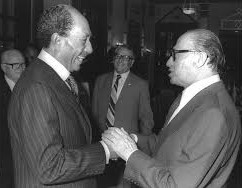Two individuals may look at the hilly terrain of Gettysburg’s Little Round Top battlefield, but may be take vastly different lessons from it.
We can be surprised when a friend describes a given event. If we attended the same event as well, it is not uncommon to conclude that our friend’s summary of it missed its meaning.
Most of us routinely function using what is sometimes called a “correspondence view of reality.” This approach assumes that the material world offers up an endless parade of experiences that we take in and understand in more or less similar ways. The reality on view to all has certain reliable and corresponding meanings. At least that’s the problematic theory.
What we notice–what sticks with us–comes from what is already in us as much as what the eye is capturing. We are not cameras. We “see” with our brains as much as our eyes
After decades as a rhetorical critic and analyst, I must say that I don’t see much evidence that details in the world we describe have much in common with what others believe to be present. We all know the experience of listening to a description of an event witnessed by ourselves and others, only to hear an account that misses what we thought were key defining features. There’s nothing new in this, but it’s a cautionary condition that ought to make us wary of the correspondence view. It may seem to counteract familiar problems of “selective perception” or “confirmation bias:” (seeing what we want to see). One would think that what is in front of our eyes commands the same cognitive processes. If it were only so. Of course artificial intelligence can now fabricate convincing images and videos. But they are mediated, or witnessed second hand, opening up what has become a huge problem about their veracity. For our purposes here let’s stay with original and personal experience. Even here, what we notice–what sticks with us–comes from what is already in us as much as what the eye was capturing. We are not cameras. We see with our brains as much as our eyes. We use even raw experience to interprete the world as it is presented.
Still, there are surprisingly different understandings that play out in all kinds of prosaic ways: a photograph we loved that others disliked, the often surprising “lessons” that individuals take away from a story about interpersonal conflict, or what was really going on with that strange conversation with a friend.
 I was reminded of this in a scene laid out in Lawrence Wright’s book on the negotiations that led to the historic Camp David Accords. Thirteen Days in September documents the 1978 efforts of President Jimmy Carter to find a way out of the chronic Arab/Israeli impasse, working with Egypt’s Anwar Sadat (left) and Israel’s Menachem Begin. The President put everything else on hold in Washington to spend time with these men at Camp David in the Maryland mountains. Days passed as these three leaders looked for a way around their considerable differences. But what a statesmanlike idea to bring these factions together in the comparative isolation of the Maryland mountains.
I was reminded of this in a scene laid out in Lawrence Wright’s book on the negotiations that led to the historic Camp David Accords. Thirteen Days in September documents the 1978 efforts of President Jimmy Carter to find a way out of the chronic Arab/Israeli impasse, working with Egypt’s Anwar Sadat (left) and Israel’s Menachem Begin. The President put everything else on hold in Washington to spend time with these men at Camp David in the Maryland mountains. Days passed as these three leaders looked for a way around their considerable differences. But what a statesmanlike idea to bring these factions together in the comparative isolation of the Maryland mountains.
Going to Camp David was only his first move. When the talks seemed to be irrevocably breaking down, Carter decided to pack up his entourage for a quick side-trip to the town of Gettysburg Pennsylvania, not far from the presidential retreat. He reasoned that perhaps a look at the bloody American fratricide that occurred on the lush hills surrounding the small town would add some needed urgency to the talks. In retrospect, that idea counts as one of the great acts of modern presidential leadership. Currently, President Trump shows the same desire to make peace in various hot spots, but he lacks the other-awareness to pull it off. By contrast, Sadat and Begin really liked the evident patience and generousity of Carter that Trump sorely lacks.
Over three days in 1863 the Confederate and Union armies saw 8,000 of their members slain and 50,000 gravely wounded. This was carnage on the scale of the 1967 Arab-Israeli Six Day War. Begin and Sadat took all of this in, with detailed narratives provided by Carter and the local National Park staff. But as Wright notes, the two old warriors saw vastly different Gettysburgs.

Known for his peace-making instincts, Sadat seemed fascinated by the strategies of the generals leading the two warring armies. The timing of attacks and counterattacks are usually at the center of most narratives about this key battleground. But to Carter’s surprise it was Begin, the old guerrilla fighter, who was sobered by the magnitude of the carnage, and especially the words of President Lincoln’s short address at the site. The Israeli leader interpreted the speech as a call for political leadership to rise above the brutal factionalism of civil war. Begin saw Gettysburg as a reminder of the horrible price that strife between neighbors can cause. Could the same magic work on the current Israeli Prime Minister?
![]() Against the simpler correspondence view of reality that we too often assume, communication analysis needs something which can be called a phenomenological view of reality. The phenomenologist tends to accept the likelihood that experience is individual rather than collective, and that the material worlds we share are still going to produce separate and unique understandings. Our personal values and biographies are likely to feed into interpretations of events that are specific, distinct, and often exclusive to us. Meaning is thus not a matter of consensus among strangers, but a mixture of ineffable and lifelong influences. In simple terms, two individuals may look at the hilly terrain of Gettysburg’s Little Round Top, but may be taking vastly different lessons from it.
Against the simpler correspondence view of reality that we too often assume, communication analysis needs something which can be called a phenomenological view of reality. The phenomenologist tends to accept the likelihood that experience is individual rather than collective, and that the material worlds we share are still going to produce separate and unique understandings. Our personal values and biographies are likely to feed into interpretations of events that are specific, distinct, and often exclusive to us. Meaning is thus not a matter of consensus among strangers, but a mixture of ineffable and lifelong influences. In simple terms, two individuals may look at the hilly terrain of Gettysburg’s Little Round Top, but may be taking vastly different lessons from it.
![]()
